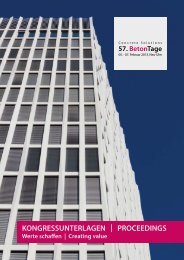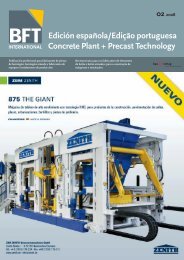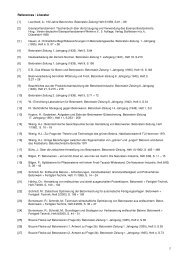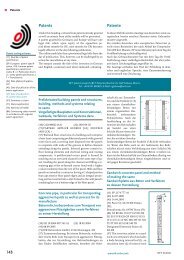Concrete Plant + Precast Technology Betonwerk ... - BFT International
Concrete Plant + Precast Technology Betonwerk ... - BFT International
Concrete Plant + Precast Technology Betonwerk ... - BFT International
Sie wollen auch ein ePaper? Erhöhen Sie die Reichweite Ihrer Titel.
YUMPU macht aus Druck-PDFs automatisch weboptimierte ePaper, die Google liebt.
22<br />
Panel 1<br />
D – Life cycle management system for the assessment of sustainability<br />
D – Lebenszyklusmanagementsystem zur Nachhaltigkeitsbeurteilung<br />
Autor<br />
Prof. Dr.-Ing. Peter Schießl,<br />
Technische Universität München<br />
schiessl@ib-schiessl.de<br />
Studium des Bauingenieurwesens<br />
an der TU München;<br />
1973 Promotion; Tätigkeit am<br />
Institut für Betonstahltechnik;<br />
1985–1998 Professor<br />
für Baustoff kunde an der<br />
RWTH Aachen und Direktor am<br />
Institut für Bauforschung; seit<br />
1998 Professur für Baustoff -<br />
kunde und Werkstoff prüfung<br />
an der TU München und Direktion<br />
des Centrums Baustoff e<br />
und Materialprüfung der TU<br />
München.<br />
Any operator of a building or structure is faced with the<br />
key task of maintaining and preserving infrastructural<br />
buildings or structures on a systematic basis and in the<br />
long term. Due to limited budgets, cost eff ectiveness considerations<br />
over the entire service life of the building or<br />
structure play a major role in this regard. In this context,<br />
it should be noted that a construction project is not necessarily<br />
economical if design and building costs are low. By<br />
contrast, any investment or capital expenditure can be assessed<br />
exhaustively from an economic point of view only<br />
if all relevant follow-up costs, such as those of required<br />
maintenance work, demolition or subsequent new construction,<br />
are included in these considerations. To provide<br />
a reliable estimate of these follow-up costs, a realistic forecast<br />
of the condition of the building or structure over time<br />
is required.<br />
In subproject D, a predictive life cycle management<br />
system (PLMS) was developed and implemented as a prototype<br />
software (Fig. 1).<br />
The underlying concept of this life cycle management<br />
system relies on a combination of probabilistic damage<br />
models to predict the condition of the building or structure<br />
and non-destructive testing methods on the basis of a<br />
three-dimensional building model with a hierarchical<br />
structure. This approach enables the direct linkage of<br />
measured values to the virtual model and their subsequent<br />
reading. In addition, the condition forecast outcome<br />
can be visualized in relation to each structural component,<br />
which makes it easier to detect weaknesses. In<br />
turn, the fi ndings of structural analyses can be used to<br />
render the original condition forecast more accurate in<br />
subsequent steps in order to continuously improve the<br />
quality of the forecast over the service life.<br />
Due to the fl exibility of its design, this system can be<br />
applied to various levels (such as components or entire<br />
structures) and to structures with varying degrees of complexity.<br />
It thus supports operators of buildings or structures<br />
in their eff orts to ensure a mode of operation that<br />
remains cost-eff ective in the long term whilst always taking<br />
account of existing user requirements.<br />
Fig. 1 User interface of the developed prototype software.<br />
Abb. 1 Benutzeroberfl äche des entwickelten Software-Prototyps.<br />
| Proceedings 54 th BetonTage<br />
Angesichts alternder Bauwerksbestände stellt die nachhaltige<br />
und systematische Erhaltung von Infrastrukturbauwerken<br />
eine zentrale Aufgabe für den Bauwerksbetreiber<br />
dar. Aufgrund limitierter Haushaltsmittel spielen<br />
hierbei besonders Wirtschaftlichkeitsbetrachtungen über<br />
die gesamte Nutzungsdauer des Bauwerks eine große<br />
Rolle. Dabei ist zu beachten, dass eine Baumaßnahme<br />
nicht zwingend dann ökonomisch ist, wenn Planungs-<br />
und Herstellungskosten gering sind. Vielmehr kann eine<br />
Investition aus ökonomischer Sicht erst dann erschöpfend<br />
beurteilt werden, wenn auch alle relevanten Folgekosten<br />
von anfallenden Erhaltungsmaßnahmen bis hin<br />
zum Abriss bzw. Neubau in die Wirtschaftlichkeitsbetrachtungen<br />
mit einfl ießen. Um diese Folgekosten zuverlässig<br />
abschätzen zu können, ist eine realitätsgetreue Prognose<br />
der Zustandsentwicklung eines Bauwerks nötig.<br />
Innerhalb des Teilprojekts D wurde ein prädiktives<br />
Lebensdauermanagementsystem (PLMS) entwickelt und<br />
in Form eines Software-Prototypen umgesetzt (Abb. 1).<br />
Das Grundkonzept des Lebensdauermanagementsystems<br />
beruht auf der Kombination probabilistischer<br />
Schädigungsmodelle zur Zustandsprognose und zerstörungsfreier<br />
Untersuchungsmethoden auf Basis eines<br />
dreidimensionalen, hierarchisch organisierten Bauwerksmodells.<br />
Auf diese Weise lassen sich beispielsweise Messergebnisse<br />
direkt am virtuellen Modell verankern und<br />
später dort ablesen. Außerdem ist das Ergebnis von Zustandsprognosen<br />
bauteilbezogen visualisierbar, wodurch<br />
Schwachstellen leichter zu erkennen sind. Die Ergebnisse<br />
der Bauwerksuntersuchungen können ihrerseits herangezogen<br />
werden, um die ursprüngliche Zustandsprognose<br />
sukzessiv zuzuschärfen und so die Prognosequalität<br />
über die Nutzungsdauer kontinuierlich zu verbessern.<br />
Aufgrund der geplanten Flexibilität kann dieses System<br />
auf unterschiedlichen Systemebenen (Bauteil bzw.<br />
Bauwerksebene) sowie für Bauwerke unterschiedlicher<br />
Komplexität angewandt werden und unterstützt somit<br />
Bauwerksbetreiber bei einem wirtschaftlich und nachhaltig<br />
optimierten Bauwerksbetrieb gemäß der Nutzeranforderungen.<br />
<strong>BFT</strong> 02/2010












